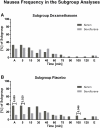Nausea and Vomiting following Balanced Xenon Anesthesia Compared to Sevoflurane: A Post-Hoc Explorative Analysis of a Randomized Controlled Trial
- PMID: 27111335
- PMCID: PMC4844115
- DOI: 10.1371/journal.pone.0153807
Nausea and Vomiting following Balanced Xenon Anesthesia Compared to Sevoflurane: A Post-Hoc Explorative Analysis of a Randomized Controlled Trial
Abstract
Objective: Like other inhalational anesthetics xenon seems to be associated with post-operative nausea and vomiting (PONV). We assessed nausea incidence following balanced xenon anesthesia compared to sevoflurane, and dexamethasone for its prophylaxis in a randomized controlled trial with post-hoc explorative analysis.
Methods: 220 subjects with elevated PONV risk (Apfel score ≥2) undergoing elective abdominal surgery were randomized to receive xenon or sevoflurane anesthesia and dexamethasone or placebo after written informed consent. 93 subjects in the xenon group and 94 subjects in the sevoflurane group completed the trial. General anesthesia was maintained with 60% xenon or 2.0% sevoflurane. Dexamethasone 4mg or placebo was administered in the first hour. Subjects were analyzed for nausea and vomiting in predefined intervals during a 24h post-anesthesia follow-up.
Results: Logistic regression, controlled for dexamethasone and anesthesia/dexamethasone interaction, showed a significant risk to develop nausea following xenon anesthesia (OR 2.30, 95% CI 1.02-5.19, p = 0.044). Early-onset nausea incidence was 46% after xenon and 35% after sevoflurane anesthesia (p = 0.138). After xenon, nausea occurred significantly earlier (p = 0.014), was more frequent and rated worse in the beginning. Dexamethasone did not markedly reduce nausea occurrence in both groups. Late-onset nausea showed no considerable difference between the groups.
Conclusion: In our study setting, xenon anesthesia was associated with an elevated risk to develop nausea in sensitive subjects. Dexamethasone 4mg was not effective preventing nausea in our study. Group size or dosage might have been too small, and change of statistical analysis parameters in the post-hoc evaluation might have further contributed to a limitation of our results. Further trials will be needed to address prophylaxis of xenon-induced nausea.
Trial registration: EU Clinical Trials EudraCT-2008-004132-20 ClinicalTrials.gov NCT00793663.
Conflict of interest statement
Figures




References
-
- Koivuranta M, Laara E, Snare L, Alahuhta S. A survey of postoperative nausea and vomiting. Anaesthesia.1997; 52: 443–449. - PubMed
-
- Apfel CC, Roewer N, Korttila K. How to study postoperative nausea and vomiting. Acta Anaesthesiol Scand.2002; 46: 921–928. - PubMed
-
- Apfel CC, Laara E, Koivuranta M, Greim CA, Roewer N. A simplified risk score for predicting postoperative nausea and vomiting: conclusions from cross-validations between two centers. Anesthesiology.1999; 91: 693–700. - PubMed
-
- Andrews PL. Physiology of nausea and vomiting. Br J Anaesth.1992; 69: 2S–19S. - PubMed
Publication types
MeSH terms
Substances
Associated data
LinkOut - more resources
Full Text Sources
Other Literature Sources
Medical

